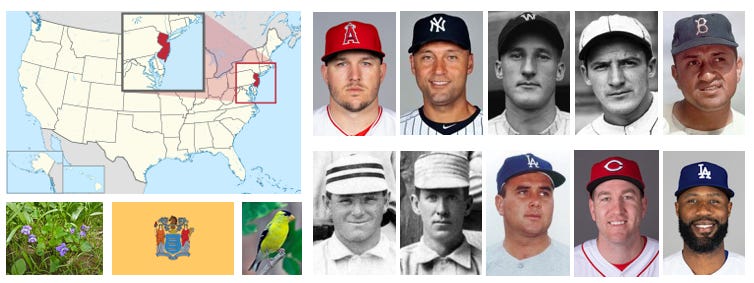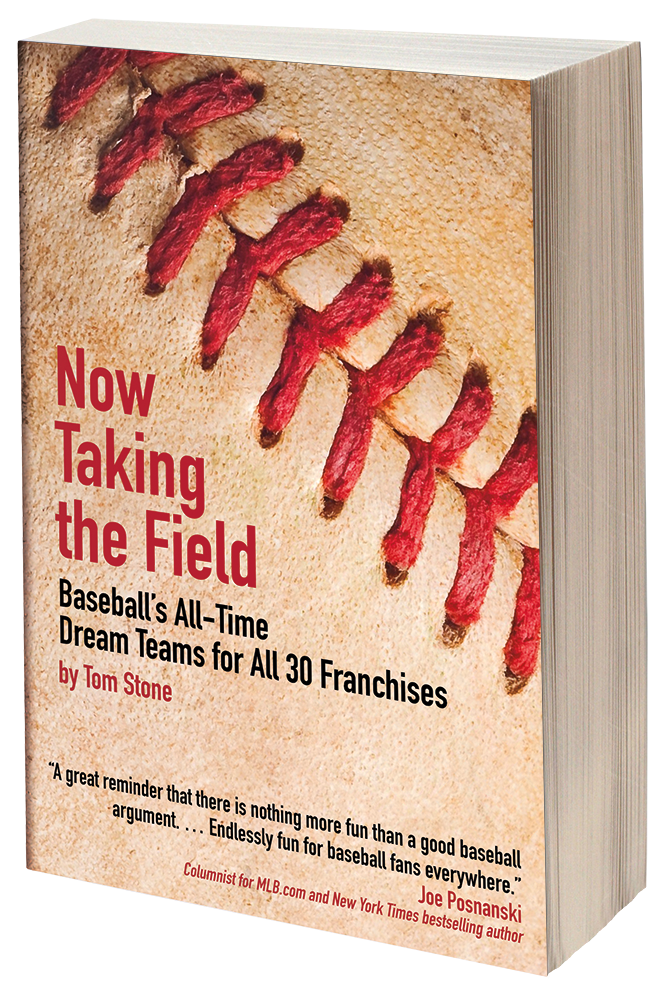New Jersey's Baseball All-Time Dream Team
What would a dream team roster look like for major league players born in New Jersey?
Issue #147
This is the 32nd article in a series where I am creating all-time dream teams for players born in each of the fifty US states. I’m publishing each write-up on the anniversary date that the particular state joined the union. So far I’ve covered Maryland, Louisiana, Minnesota, South Carolina, Rhode Island, Wisconsin, Kentucky, Tennessee, Arkansas, West Virginia, New Hampshire, Virginia, Idaho, Wyoming, New York, Colorado, Missouri, Hawaii, California, Nevada, North and South Dakota, Montana, Washington, Oklahoma, North Carolina, Illinois, Delaware, Mississippi, Indiana, Pennsylvania, and Alabama.
Next up is New Jersey, which on December 18, 1787 became the third state (following Delaware and Pennsylvania) to ratify the United States Constitution (according to Wikipedia).
Important caveat to what follows: I’m creating these all-time dream teams based on the birthplace data available at baseball-reference.com. I realize this might mean some players will appear for a state’s all-time dream that seems odd, e.g., a player who was born in one state but lived there only briefly, while then spending most of his youth, or especially critical years playing baseball in high school in another state. So that is an important caveat to the below dream team roster—and I’ll discuss the players that I know went to high school in a state other than New Jersey towards the end of this article (and vice-versa, those born elsewhere but who went to high school in New Jersey.)
Here is the all-time dream team I came up with for players born in New Jersey:
New Jersey is the fifth-smallest state by in land area, but has always been quite populated—according to the 2020 census, it ranks 11th by population. So you’d expect this all-time dream team to have some solid star names, and sure enough there are four Hall of Famers in SS Derek Jeter, CF Billy Hamilton (the one from the 19th Century), and LF Goose Goslin and Joe Medwick. And arguable the best player on the roster is future Hall of Famer CF Mike Trout.
Obviously the OF is the biggest strength of this roster, with four of the five guys just mentioned being primarily CF and LF. In RF there is another strong 19th century hitter in Mike Tiernan who played from 1887-1899 with a .311/.392/.463 slash line, 138 OPS+, 428 SB, and seven seasons with 100+ runs. And Jason Heyward was an All-Star in his 2010 rookie campaign and has had a few good offensive seasons, with his elite defense bringing him five NL Gold Glove Awards.
Aside from Jeter at SS, this roster’s infield isn’t nearly as strong. 2B Eric Young Sr. provided speed, with six seasons of 40+ SB and 465 total in his career, while 3B Todd Frazier provided power, with four seasons of 25+ HR and highs of 35 and 40 in 2015 and 2016.
Starting lineups for this all-time dream team could look like this:
Against RHP:
Billy Hamilton / Mike Tiernan (L) RF
Goose Goslin (L) LF
Mike Trout (R) CF
Joe Medwick (R) DH
Joe Cunningham / Sean Casey (L) 1B
Derek Jeter (R) SS
Todd Frazier (R) 3B
John Romano / Earl Williams (R) C
Eric Young Sr. (R) 2B
Against LHP:
Billy Hamilton / Mike Tiernan (L) RF
Derek Jeter (R) SS
Mike Trout (R) CF
Joe Medwick (R) DH
Eric Karros (R) 1B
Goose Goslin (L) LF
Todd Frazier (R) 3B
John Romano / Earl Williams (R) C
Eric Young Sr. (R) 2B
I already noted Tiernan’s high batting average and SB totals, but his contemporary “Sliding” Billy Hamilton (1888-1901) did better in both aspects of the game with a .344/.455/.432 slash line and 914 SB, including five league-leading seasons of 90+ SB. While he was primarily a CF, I need to keep Trout in the lineup everyday, so Hamilton and Tiernan can share RF while naturally hitting leadoff.
Much of the rest of these lineups seemed pretty clear-cut, with Jeter hitting second against LHP but flipping spots with the lefty-swinging Goslin against RHP. Medwick is the everyday DH and can hit cleanup behind Trout. There are three guys who can share 1B, with the right-handed Eric Karros and his five seasons of 30+ HR and 100+ RBI playing against LHP, and lefties Joe Cunningham (.291/.403/.417, 120 OPS+) and Sean Casey (.302/.367/.447, 109 OPS+) sharing the duties against RHP.
The two catchers on the roster hit right-handed, so I listed them both in the eighth spot. John Romano played from 1958-1967 and was an All-Star in both 1961 and 1962 when he hit 20+ HR with 80+ RBI each year. After lighting up minor-league pitching in 1969 and 1970, Earl Williams won the 1971 NL Rookie of the Year award after hitting 33 HR with 87 RBI. He was a below-average defensive catcher, so he’d often play 1B, 3B, or DH to keep his bat in the lineup.
As for the pitching staff, you could argue over who the ace of the rotation should be. I went with Don Newcombe, who pitched briefly in the Negro Leagues before signing with the Brooklyn Dodgers and pitching well in the minors for three seasons. In his age-23 season in 1949 he won the NL Rookie of the Year Award after going 17-8 with a 3.17 ERA and a league-high five shutouts. A four-time All-Star, his best season came in 1956 when he posted a 27-7 record with a 3.06 ERA—earning him both the NL Cy Young Award and NL MVP Award.
Andy Messersmith (1968-1979) was also a four-time All-Star, won 20+ games twice, won two Gold Glove Awards, and was top-five in the Cy Young voting three times. Al Leiter pitched in the majors in 19 seasons, but it took a while for him to stick as he only got into 31 games (23 starts) with a 5.00 ERA across six seasons from 1987-1992. But after his time in the AL with the Yankees and Blue Jays, he shined in the NL with the Marlins and Mets, winning 10-17 games each year from 1996-2004 and being named an All-Star twice.
After those three, how you rank the other starters I included could also be debated. Of particular note is the long baseball career of old-timer William Jethro “Kid” Gleason. He started out primarily as a pitcher from 1888-1894, posting a 138-131 record with an impressive 38-17 record, 2.68 ERA, and 139 ERA+ in 1890. When not pitching Gleason would sometimes play other positions, and when his pitching declined at the same time his hitting improved, he was shifted to primarily playing 2B full-time in 1895. He didn’t have much power, but ran pretty well stealing 20+ bases six times. After coaching for many years, Gleason became manager of the White Sox for five years (1919-1923)—though his first campaign as skipper was unfortunately the year of Black Sox Scandal where some of his players cheated in the World Series. From 1926-1931 Gleason also served as a coach for the Athletics under long-time manager Connie Mack.
Beyond the eight starters I included, there were a few others that I considered and that at least deserve honorable mention, including: Joe Black, Erik Hanson, John Montefusco, Charlie Morton, Zac Gallen, Hank Borowy, and Jim Bouton.
The bullpen on this dream team is led by Ron Perranoski, who was the Dodgers’ key reliever in the mid-1960s and went 16-3 with a 1.67 ERA in 129 relief innings in 1963, earning him fourth place in the NL MVP voting. Later with the Twins he led the AL with 31 saves in 1969 and 34 saves in 1970.
Andrew Bailey had an eight-year major league career, but his first three seasons in 2009-2011 were by far his best. He was an All-Star as a rookie for Oakland and won the AL ROY year of the award after posting a 1.84 ERA with 26 saves. He was an All-Star again the next year and posted a 1.47 ERA with 25 saves.
Rawly Eastwick was a key reliever for the Big Red Machine World Champions in 1975 and 1976, leading the NL with 22 and 26 saves in those two seasons. But after those three, how you rank the other relievers on this dream team roster could be debated.
What about players who went to High School in New Jersey?
As noted at the outset of this article, and as I’ve done for my other US State dream team write-ups, what if you change the criteria from players who were born in the state of New Jersey to players who grew up—which we’ll define as going to high school—in the state of New Jersey?
First off, some of the players on the roster above were born in New Jersey but went to high school elsewhere, including:
SS Derek Jeter – Michigan
RF Jason Heyward – Georgia
1B Sean Casey – Pennsylvania
1B Eric Karros – California
SP Andy Messersmith – California
SP/2B Kid Gleason – Pennsylvania
If we eliminate those players from the above roster, the biggest losses would be felt at SS and 1B. On the other hand, I found several guys who were born elsewhere but went to high school in the state of New Jersey and would be deserving of roster spots here:
SS/3B John Valentin – New York
CF Larry Doby – South Carolina
CF/LF Willie Wilson – Alabama
LF Monte Irvin – Alabama
OF Richie Zisk – New York
SP Orel Hershiser – New York
SP George McQuillan – New York
RP Sean Doolittle – South Dakota
Adding John Valentin wouldn’t make up for the loss of Jeter, but he would clearly step in as the starting SS. The already crowded OF would become even more so, with Larry Doby the only one who would likely get much playing time—perhaps in a platoon with Medwick at DH. And Orel Hershiser would slot in nicely as the number two starter, replacing Messersmith in the rotation.
All data is from Baseball-Reference.com, and also their subscription service Stathead.com. If you are a big sports fan, be sure to check out the latest features at Stathead and the Sports Reference family of sites. The state map, flag, flower, and bird images are from Wikipedia.
Did you know? I wrote a book with the same title as this Substack newsletter / blog: Now Taking the Field: Baseball’s All-Time Dream Teams for All 30 Franchises. It was published in early 2019, by ACTA Sports, the publisher of the annual Bill James Handbook and other popular titles. You can learn more about it at www.NowTakingTheField.com, or buy directly at Amazon and other booksellers.






